|
Common names:
Australia |
English |
Darwin's mudskipper |
China |
Chinese Mandarin |
达尔文弹涂鱼 (Da er wen tan tu yu - Darwin mudskipper)* |
Italy |
Italian |
perioftalmo di Darwin* |
Papua New Guinea |
Purutu language |
sakomo |
* proposed name
|
|
|
Synonyms:
Etymology:
'Periophthalmus' is a compound name from the Greek 'peri' (around), and 'ophthalmôn' (eye), which refers to the wide visual field of these species
the specific name is after Charles Darwin, after whom Darwin Harbour (where the holotype was collected) was named (Larson and Takita, 2004)
|
Maximum recorded length:
45 mm SL (Larson and Takita, 2004; Polgar et al., 2010)
Live colouration
(Larson and Takita, 2004; Polgar et al., 2010; Takita et al., 2011):
background colour light brown to greyish on dorsum and flankes, ventrally whitish; head
with dark brown streaks and mottling on dorsum, ventrally white; 7-8 dorsal dark brown saddle-like diagonal and irregular bars, usually well evident; dark brown blotches between bars may be present. D1 light brown basally, medially dark brown, and with a
transparent margin; D2 transparent with two parallel series of dark brown speckles on elements: the medial series can be expanded into a medial brown stripe; caudal fin dusky, with series of brown speckles along rays;
anal fin hyaline; pelvic fins whitish ventrally, dorsally brownish; pectoral fins hyaline with brownish rays
Colouration on preservation
(Larson and Takita, 2004; pers. obs.: Papua New Guinea; Australia NT):
ground colour dorsally and laterally grey to light brown, ventrally paler; chin and isthmus may be brownish; dark dorsal banded pattern and blotches usually visible; D1 brownish
with a transparent margin;
D2 transparent with two series of dusky speckles, or a dusky medial stripe and a proximal series of dusky speckles on elements; caudal fin dusky with series of
brown speckles on rays; pectoral fins dusky; pelvic
and anal fins whitish
Diagnosis (Larson and Takita, 2004):
total D2 elements 11-13; total anal fin elements 12-14; pectoral fin rays 11-14; longitudinal scale count 58-78; predorsal scales 20-30; pelvic fins united
for half their length, with a distinct pelvic frenum, and with tips pointed to bluntly pointed; D1 greatly reduced in both sexes (depressed D1
length 5.1-9.6% of SL; spines IV-VI), and widely separated from D2.
The genus is yet undefined by synapomorphies
Diet (pers. obs.: Australia, NT, Papua New Guinea):
carnivorous; it can be frequently observed chasing crabs and other small invertebrates; no published study is available
|
|
Reproduction:
no published study is available
|
|
|
|
|
Ecological notes (Polgar et al., 2010; Takita et al., 2011):
locally very abundant in the intertidal zone, along mud banks of tidal creeks and inlets, never far from mangrove trees. P. darwini forms dense aggregations, and seems to be relatively less aggressive than other congeneric species
left: bank of a tidal creek: here P. darwini was found on top of the vegetated banks and inside the forest at low tide
(Purutu Is., Fly river delta, Papua New Guinea)
right: a small stand of Avicennia and Rhizophora spp. along a small stream at low tide. Also here P. darwini was always found nearby the trees (Doctor's Gully, Darwin, Northern Territory, Australia)
(photos, left: A. Sacchetti, 2007, with permission; right: G. Polgar, 2007)
|
|
|
|
|
Distribution (Larson & Takita, 2004; Polgar et al., 2010):
northern Australia, Papua New Guinea;
type locality: Shoal Bay, Australia, NT
|
|
|
Remarks:
when Larson & Takita (2004) described this species, they found several specimens of P. darwini in the lots identified by Murdy (1989) as P. novaeguineaensis Eggert.
Later on, Jaafar & Larson (2008) also found that 3 paralectotipes of P. novaeguineaensis Eggert are P. darwini, and that 2 specimens in the lot NTM S.10429-025 (5) are P. takita. Both Larson & Takita (2004) and Jaafar & Larson (2008) found 14 P. darwini e 27 specimens of an unidentified Periophthalmus species in the lot NTM S. 10694-001 (P. novaeguineaensis Eggert sensu Murdy, 1989).
The apparent incongruency between Larson & Takita (2004) and Jaafar & Larson (2008) on lots NTM S. 11114-002 (5) and NTM S. 15801-001 (8 paratypes), is just a typo in the latter publication: both lots are P. darwini (H.K. Larson, pers. comm., 2009).
|
Photographs of Periophthalmus darwini:
|
|
A: holotype of P. darwini (NTM-S-10554-004) (photo: G. Polgar, MAGNT, Darwin, Northern Territory, Australia, 2007); B,
C: a burrow with its owner nearby a small creek at low tide (photos: G. Polgar, Vestey's Creek, Darwin, Northern Territory, Australia, 2007);
D-G: P. darwini in a small mangrove forest, at low tide (D, E), and at high tide (G), perching on a mangrove trunk (photos: G. Polgar, Doctor's Gully,
Darwin, Northern Territory, Australia, 2007); H: another specimen on a creek's mud bank (photo: G. Polgar, Purutu Is., Fly river delta, Papua New Guinea, 2007); I, J: other shots of P. darwini on a creek's mud bank (photo: G. Polgar, Buffalo Creek, Northern Territory, Australia, 2007); K: P. darwini preying a small crab (photo: G. Polgar, Ludmilla Creek, Darwin, Northern Territory, Australia, 2007)
|
Drawings of Periophthalmus darwini:
left: cephalic sensory and nasal pores of Periophthalmus spp.: an= anterior nostril; pn= posterior nostril
(modified from Murdy, 1989)* - * with permission
|




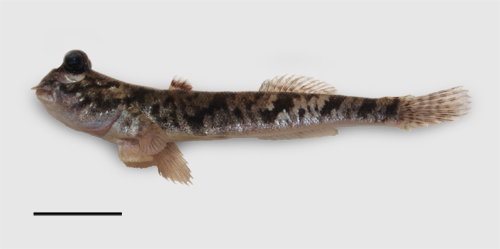
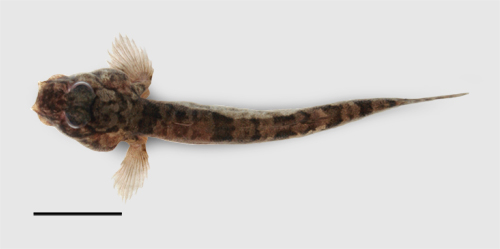
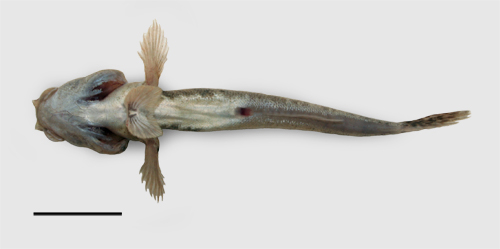
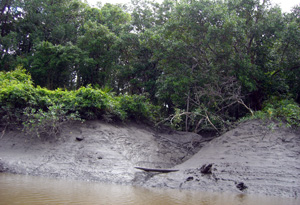
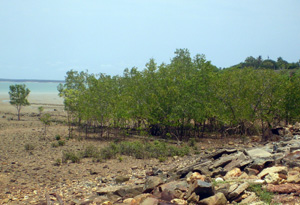
![]()